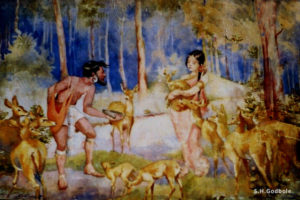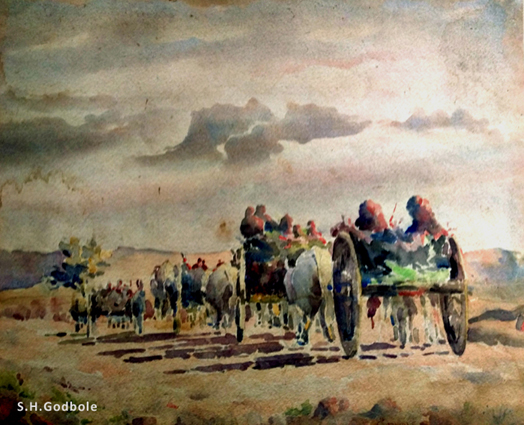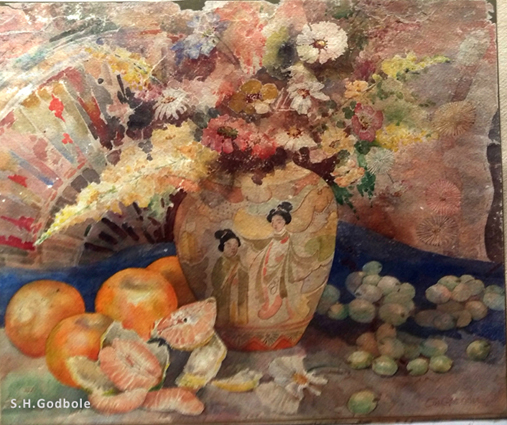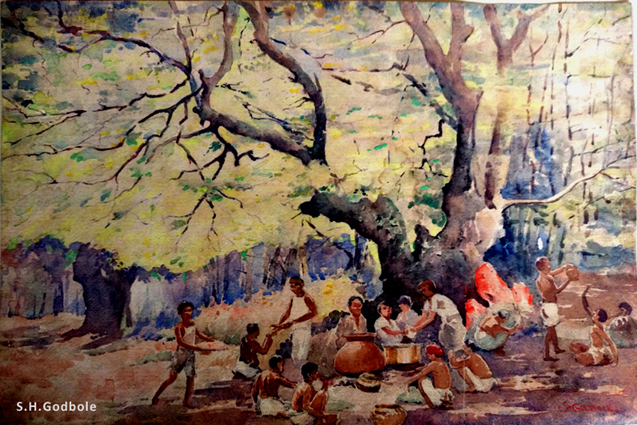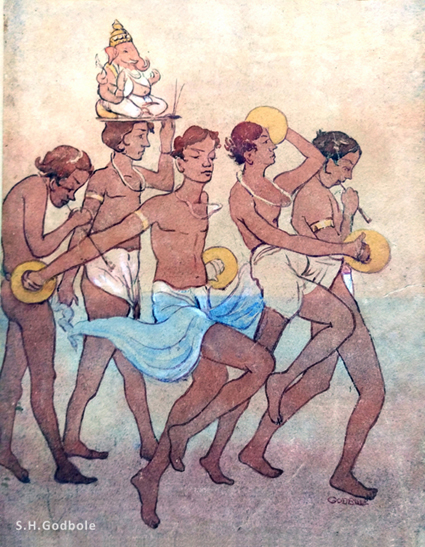“Ravana’s encounter with Sita in Panchavati”, by S.H.Godbole, watercolor, Pune, 1932
Ravana had kidnapped Sita during this first encounter in Panchavati. Rama and Sita had spent the happiest years of their life in exile in the idyllic forests in Panchavati. In Ravana’s estimate the beautiful and devoted Sita who had followed her exiled husband into the forest embodied the highest ideals of womanhood. Ravana considered Sita to be more precious than the hordes of beautiful women that had flocked to the glamour and opulence of Lanka. He considered her to be more precious even than his chief queen, the devoted Mandodari. In short Ravana was determined to possess Sita at any cost. He also had heard from his sister Shoorpanakha how attached Rama was to Sita. He was aware that taking Sita away from Rama would drive Rama to insurmountable grief and make him vulnerable to defeat in combat. However, Sita was protected by Rama, who was invincible with his Kodanda bow and the numerous Astra weapons he had acquired from the sages of Dandakaranya. There was also Rama’s brother Laxmana to assist him. Therefore Sita could be abducted only when Rama and Laxmana were removed from the scene, even briefly. Therefore Ravana hatched a plan with the help of his ally Maricha to achieve these goals. Ravana was a learned as well as clever man. He understood the vulnerabilities of a woman in Sita’s situation. On Ravana’s instructions Maricha appeared in Panchavati in the guise of a dazzling, golden deer. Sita was tempted by the thought of acquiring the beautiful skin of that deer, so she could make a blouse of that skin. She persuaded Rama to go after that golden deer to hunt and fetch his skin. Sita and Laxman were left behind in the ashram. Just then they heard Rama calling out Laxmana for help. In truth it was the deceitful Maricha calling out in Rama’s voice. Laxmana would not believe that Rama would need help going after a mere deer. Laxmana refused to budge. Thereupon Sita accused Laxmana that he did not want to rush to where Rama was shouting for help only because he secretly wished Rama to perish, so he, Laxmana, could have her alone in that wilderness. This was too much for Laxmana to take. Laxmana was devoted to both Rama and Sita more than to his own life. Laxmana created a protective ring around the ashram, the ‘Laxmana Rekha’ (line), by the dint of his devotion and rushed to where Rama would be. With both Rama and Laxmana away Ravana approached Sita in the disguise of a hermit. What transpired between Sita and Ravana is nearly inconceivable. Sita had just spoken the harshest words imaginable to Laxmana to make him rush to Rama’s help. Sita did not shout out to the approaching hermit about the grave danger in which her beloved Rama was. She did not implore the mendicant hermit to rush to where Rama was. She forgot about Laxmana’s sincere request and warning to stay inside the Laxmana Rekha. Different versions of the Ramayana seem to give different accounts of how Sita left the safety of the ashram and was lured to cross the Laxmana Rekha. Certainly all the events of that fateful afternoon indicate that Sita was acting unlike her usual character. She had prevailed upon Rama to go after the elusive deer against his intuition that the deer was an elusive creation. She had grievously hurt Rama’s devoted brother by accusing him of having devious motivations upon her.
According to traditional accounts Sita felt obliged to treat the unknown, strange mendicant at the gate of the ashram (in whose disguise demon Ravana had appeared) with utmost respect and hospitality. Traditional visual depictions considerably vary in their treatment of this scene. Some show Ravana as a furious sanyasi that is demanding respect from the householder Sita. In other depictions Ravana is scarcely able to hide his real demonic self. Neither of these two extreme depictions explain what spell Ravana cast on Sita that she was “lured” to approach Ravana, totally forgetting the grave danger Rama was in.
Artist Godbole’s interpretation appears to offer a different explanation. It appears to point out that the clever Ravana had great understanding of a woman in Sita’s situation. Sita had spent 13 years of the exile in the total protection of Rama and Laxmana. Here was the rare occasion when Sita was on her own without Rama or Laxmana around. The clever Ravana is seen approaching Sita neither as a sanyasi to be respected nor as a fearful demon who can scarcely disguise his real self. Ravana is seen here as a youthful, courteous, even likeable wanderer of the forest. Sita is surrounded by deer. She is carrying a fawn in her arm. Sita appears to be pondering upon this cavalier creature in curious attire. Here Ravana seems to be in acute understanding of the mental state of an overprotected young woman approached by an exotic stranger with unfamiliar intentions. This depiction seems to suggest that Ravana “lured” Sita to cross the Laxmana Rekha rather than “blackmail” her to cross it. Clearly this interpretation comes out of a deep understanding of the cleverness of Ravana as well as the out-of-character all-too-human sentiments exhibited by Sita on that fateful afternoon that disrupted the idyllic life that Rama and Sita were living in Panchavati and set the stage for the ultimate confrontation of all-out war between Rama and Ravana that led to the annihilation of Ravana along with his invincible Lanka. Godbole’s depiction of Ravana’s encounter with Sita is entirely different than traditional understanding of that meeting. It appeared to be plausible and convincing only to the rare individuals who had meditated upon those events in intimate detail.
It may be observed that Artist Godbole had profound and unorthodox ambitions about the prowess of an inspired artist in bringing out profound nuances in our collective consciousness.
With the emergence of Rasa Renaissance we can now realize that Artist Godbole was far ahead of his time.
